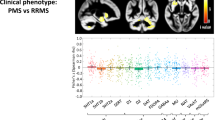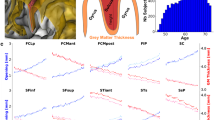Abstract
There is extensive grey matter volume (GMV) reduction in multiple sclerosis (MS), which may account for cognitive impairment in this disabling disorder. Although genome-wide association studies (GWASs) have identified hundreds of genes associated with MS, we know little about which genes associated with GMV reduction and cognitive decline in MS. In the present study, we aimed to uncover genes associated with GMV reduction in MS by performing cross-sample (1473 brain tissue samples) partial least squares regression between gene expression from 6 postmortem brains and case–control GMV difference of MS from a meta-analysis of 1391 patients and 1189 controls (discovery phase) and from the intergroup comparison between 69 patients and 70 controls (replication phase). We identified 623 genes whose brain spatial expression profiles were significantly associated with GMV reduction in MS. These genes showed significant enrichment for MS-related genes identified by GWAS; were functionally associated with ion channel, synaptic transmission, axon and neuron projection; and showed more significant cell type-specific expression in neurons than other cell types. More importantly, the identified genes showed significant enrichment for those genes with downregulated rather than upregulated expression in MS. The spatial distribution patterns of the expression of the identified genes showed more significant correlations with brain activation patterns of memory and language tasks. These findings indicate that grey matter atrophy in MS may be resulted from the joint effects of multiple genes that are associated with this disorder, especially genes with downregulated expression in MS.





Similar content being viewed by others
References
Lublin FD, Reingold SC, Cohen JA, Cutter GR, Sørensen PS, Thompson AJ, Wolinsky JS et al (2014) Defining the clinical course of multiple sclerosis: the 2013 revisions. Neurology 83:278–286
Singh S, Dallenga T, Winkler A, Roemer S, Maruschak B, Siebert H, Brück W et al (2017) Relationship of acute axonal damage, Wallerian degeneration, and clinical disability in multiple sclerosis. J Neuroinflam 14:57
Calabrese M, Magliozzi R, Ciccarelli O, Geurts JJ, Reynolds R, Martin R (2015) Exploring the origins of grey matter damage in multiple sclerosis. Nat Rev Neurosci 16:147–158
Eshaghi A, Marinescu RV, Young AL, Firth NC, Prados F, Jorge Cardoso M, Tur C et al (2018) Progression of regional grey matter atrophy in multiple sclerosis. Brain 141:1665–1677
Zivadinov R, Jakimovski D, Gandhi S, Ahmed R, Dwyer MG, Horakova D, Weinstock-Guttman B et al (2016) Clinical relevance of brain atrophy assessment in multiple sclerosis. Implications for its use in a clinical routine. Expert Rev Neurother 16:777–793
Matsushita T, Madireddy L, Sprenger T, Khankhanian P, Magon S, Naegelin Y, Caverzasi E et al (2015) Genetic associations with brain cortical thickness in multiple sclerosis. Genes Brain Behav 14:217–227
Patsopoulos NA (2018) Genetics of multiple sclerosis: an overview and new directions. Cold Spring Harb Perspect Med. https://doi.org/10.1101/cshperspect.a028951
Consortium IMSG (2019) Multiple sclerosis genomic map implicates peripheral immune cells and microglia in susceptibility. Science 365:eaav7188
Gandhi KS, McKay FC, Cox M, Riveros C, Armstrong N, Heard RN, Vucic S et al (2010) The multiple sclerosis whole blood mRNA transcriptome and genetic associations indicate dysregulation of specific T cell pathways in pathogenesis. Hum Mol Genet 19:2134–2143
Hibar DP, Stein JL, Renteria ME, Arias-Vasquez A, Desrivières S, Jahanshad N, Toro R et al (2015) Common genetic variants influence human subcortical brain structures. Nature 520:224–229
Panizzon MS, Fennema-Notestine C, Eyler LT, Jernigan TL, Prom-Wormley E, Neale M, Jacobson K et al (2009) Distinct genetic influences on cortical surface area and cortical thickness. Cereb Cortex 19:2728–2735
Hawrylycz MJ, Lein ES, Guillozet-Bongaarts AL, Shen EH, Ng L, Miller JA, van de Lagemaat LN et al (2012) An anatomically comprehensive atlas of the adult human brain transcriptome. Nature 489:391–399
Hawrylycz M, Miller JA, Menon V, Feng D, Dolbeare T, Guillozet-Bongaarts AL, Jegga AG et al (2015) Canonical genetic signatures of the adult human brain. Nat Neurosci 18:1832–1844
Romme IA, de Reus MA, Ophoff RA, Kahn RS, van den Heuvel MP (2017) Connectome disconnectivity and cortical gene expression in patients with schizophrenia. Biol Psychiatry 81:495–502
Romero-Garcia R, Warrier V, Bullmore ET, Baron-Cohen S, Bethlehem RAI (2019) Synaptic and transcriptionally downregulated genes are associated with cortical thickness differences in autism. Mol Psychiatry 24:1053–1064
Radua J, Mataix-Cols D (2012) Meta-analytic methods for neuroimaging data explained. Biol Mood Anxiety Disord 2:6
Radua J, Mataix-Cols D, Phillips ML, El-Hage W, Kronhaus DM, Cardoner N, Surguladze S (2012) A new meta-analytic method for neuroimaging studies that combines reported peak coordinates and statistical parametric maps. Eur Psychiatry 27:605–611
Radua J, Mataix-Cols D (2009) Voxel-wise meta-analysis of grey matter changes in obsessive-compulsive disorder. Br J Psychiatry 195:393–402
Egger M, Smith GD, Phillips AN (1997) Meta-analysis: principles and procedures. BMJ 315:1533–1537
Ashburner J (2007) A fast diffeomorphic image registration algorithm. Neuroimage 38:95–113
Arnatkevic Iūtė A, Fulcher BD, Fornito A (2019) A practical guide to linking brain-wide gene expression and neuroimaging data. Neuroimage 189:353–367
Desikan RS, Ségonne F, Fischl B, Quinn BT, Dickerson BC, Blacker D, Buckner RL et al (2006) An automated labeling system for subdividing the human cerebral cortex on MRI scans into gyral based regions of interest. Neuroimage 31:968–980
Bigdeli TB, Lee D, Webb BT, Riley BP, Vladimirov VI, Fanous AH, Kendler KS et al (2016) A simple yet accurate correction for winner’s curse can predict signals discovered in much larger genome scans. Bioinformatics 32:2598–2603
de Leeuw CA, Mooij JM, Heskes T, Posthuma D (2015) MAGMA: generalized gene-set analysis of GWAS data. PLoS Comput Biol 11:e1004219
Pers TH, Karjalainen JM, Chan Y, Westra HJ, Wood AR, Yang J, Lui JC et al (2015) Biological interpretation of genome-wide association studies using predicted gene functions. Nat Commun 6:5890
Tusher VG, Tibshirani R, Chu G (2001) Significance analysis of microarrays applied to the ionizing radiation response. Proc Natl Acad Sci USA 98:5116–5121
Quintana DS, Rokicki J, van der Meer D, Alnæs D, Kaufmann T, Córdova-Palomera A, Dieset I et al (2019) Oxytocin pathway gene networks in the human brain. Nat Commun 10:668
Yarkoni T, Poldrack RA, Nichols TE, Van Essen DC, Wager TD (2011) Large-scale automated synthesis of human functional neuroimaging data. Nat Methods 8:665–670
Chiang FL, Wang Q, Yu FF, Romero RS, Huang SY, Fox PM, Tantiwongkosi B et al (2019) Clin Radiol 74:816 e819-816 e828
Lansley J, Mataix-Cols D, Grau M, Radua J, Sastre-Garriga J (2013) Localized grey matter atrophy in multiple sclerosis: a meta-analysis of voxel-based morphometry studies and associations with functional disability. Neurosci Biobehav Rev 37:819–830
Cifelli A, Arridge M, Jezzard P, Esiri MM, Palace J, Matthews PM (2002) Thalamic neurodegeneration in multiple sclerosis. Ann Neurol 52:650–653
Houtchens MK, Benedict RH, Killiany R, Sharma J, Jaisani Z, Singh B, Weinstock-Guttman B et al (2007) Thalamic atrophy and cognition in multiple sclerosis. Neurology 69:1213–1223
Campbell GR, Worrall JT, Mahad DJ (2014) The central role of mitochondria in axonal degeneration in multiple sclerosis. Mult Scler 20:1806–1813
Schattling B, Eggert B, Friese MA (2014) Acquired channelopathies as contributors to development and progression of multiple sclerosis. Exp Neurol 262(Pt A):28–36
Farina M, Avila DS, da Rocha JB, Aschner M (2013) Metals, oxidative stress and neurodegeneration: a focus on iron, manganese and mercury. Neurochem Int 62:575–594
Hagemeier J, Ramanathan M, Schweser F, Dwyer MG, Lin F, Bergsland N, Weinstock-Guttman B et al (2018) Iron-related gene variants and brain iron in multiple sclerosis and healthy individuals. Neuroimage Clin 17:530–540
Mandolesi G, Grasselli G, Musumeci G, Centonze D (2010) Cognitive deficits in experimental autoimmune encephalomyelitis: neuroinflammation and synaptic degeneration. Neurol Sci 31:S255-259
Mandolesi G, Gentile A, Musella A, Fresegna D, De Vito F, Bullitta S, Sepman H et al (2015) Synaptopathy connects inflammation and neurodegeneration in multiple sclerosis. Nat Rev Neurol 11:711–724
Dutta R, Trapp BD (2007) Pathogenesis of axonal and neuronal damage in multiple sclerosis. Neurology 68:S22-31 (discussion S43-54)
Friese MA, Schattling B, Fugger L (2014) Mechanisms of neurodegeneration and axonal dysfunction in multiple sclerosis. Nat Rev Neurol 10:225–238
Brochet B, Ruet A (2019) Cognitive impairment in multiple sclerosis with regards to disease duration and clinical phenotypes. Front Neurol 10:261
De Looze C, Moreau N, Renié L, Kelly F, Ghio A, Rico A, Audoin B et al (2019) Effects of cognitive impairment on prosodic parameters of speech production planning in multiple sclerosis. J Neuropsychol 13:22–45
Acknowledgements
We thank Yujing Li, Ying Fu and the Neuroimmunology team at the General Hospital for patient recruitments and collection of clinical data.
Funding
This work was supported by the National Key Research and Development Program of China (Grant number 2018YFC1314300), the National Natural Science Foundation of China (Grant numbers 82030053, 82071907, and 81425013), the Tianjin Key Technology R&D Program (Grant number 17ZXMFSY00090), the Natural Science Foundation of Tianjin City (Grant number 18JCQNJC80200), the Research Fund for Young Scholars of Tianjin Medical University General Hospital (Grant number ZYYFY2019004) and the Tianjin Health Commission Science and Technology Talent Cultivation Project (Grant number KJ20102).
Author information
Authors and Affiliations
Contributions
JS and CY designed research. JS and YYX performed the experiments and analyzed the data. JS, NNNZ and QHW were involved in the clinical assessment. JLS and WQ provided guidance and advice. JS and CY drafted and revised the paper. All authors discussed the results.
Corresponding authors
Ethics declarations
Conflicts of interest
All authors claim that there are no conflicts of interest.
Ethics approval
The study was approved by the Medical Research Ethics Committee of Tianjin Medical University.
Supplementary Information
Below is the link to the electronic supplementary material.
Rights and permissions
About this article
Cite this article
Sun, J., Xie, Y., Wang, Q. et al. Genes associated with grey matter volume reduction in multiple sclerosis. J Neurol 269, 2004–2015 (2022). https://doi.org/10.1007/s00415-021-10777-2
Received:
Revised:
Accepted:
Published:
Issue Date:
DOI: https://doi.org/10.1007/s00415-021-10777-2




